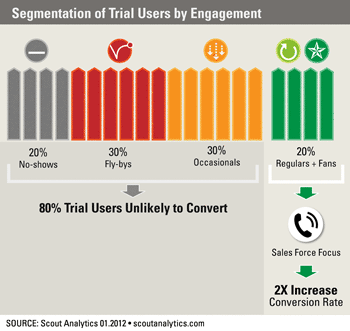
Is your trial conversion rate hovering in the single digits? Research indicates that you’re not alone. In fact, the average for a subscription business is below 10%. While it’s unlikely you’ll ever reach or maintain conversion rates that are closer to 100%, targeting the right segment of customers during the initial phase is key to increasing your conversions.
Matt Shanahan of Scout Analytics has found that focusing efforts towards your most engaged prospects is key to boosting your conversions and revenue.
Behavioral Segmentation Matters
Kissmetrics Research has found that customer segmentation is key to increasing conversions. Gathering qualitative data aggressively throughout the trial period is key to identifying the best prospects to have your sales team focus on. Shanahan writes that without behavioral data, there’s a 100% chance that your sales team will be engaging the wrong prospects. While his observation is humorous, it’s true. Subscription businesses are increasingly finding that basic information on demographics isn’t always the best prediction of who has the potential to convert after the 30-day trial ends.
It’s Not All About Budget
Any owner of a subscription business intuitively knows that many of their prospects will fail to sign up due to budgetary reasons. If they don’t have the funds or the decision-making ability to invest in the service, they’ll never become paying customers. Others do have the ability to convert, but it’s unreasonable to expect that everyone will. Your subscription business can’t be everything to everyone, which is why the metrics surrounding their engagement with the software are critical.
Behaviors that Don’t Convert
An estimated 80% of your trial subscribers are probably displaying behaviors that are not likely to lead to conversions. Around 20% are no-shows, defined as signing up for the trial and failing to spend any time engaged. 30% are fly-bys, who spent a few minutes using the service after signing up for the trial, and don’t come back. Even if this 50% appear to be highly qualified leads based on demographic data or job titles, contact from your sales team is highly unlikely to result in conversions. Shanahan recommends you avoid putting resources towards engaging. Finally, an 30% may engage on a regular basis, but their usage patterns aren’t high.

Source: Scout Analytics
Finding the 20%
The 20% of your trial subscribers who engage with your subscription business on a regular basis are the low-hanging fruit for your sales team. This segment actively adopted the software into their workflow from the beginning, and their total time engaged and number of log-ins reflects the fact they’re using the software on a daily basis . They may actively ask questions or connect on social media. This segment is classified as fence sitters, and without contact from your sales team, they may not convert at the end of the trial.
If your prospects aren’t finding value in your subscription business, there’s little value in trying to convert them into clients. Behavioral data is key, and determining who is regularly using the software and has become a fan of the service is the best way to increase your conversions rate and use your sales resources appropriately. While demographics remain a valuable tool for qualifying leads, qualitative analysis of engagement reveals potential for conversion far more effectively than a simple look at job title and budget.




